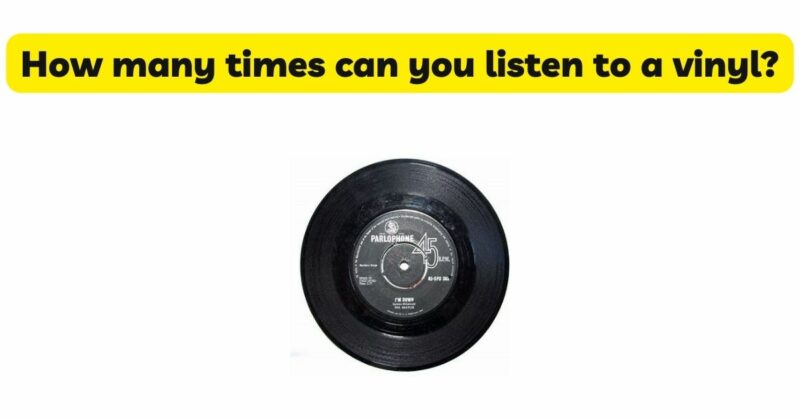Vinyl records have experienced a remarkable resurgence in recent years, captivating music enthusiasts with their unique sound and tactile appeal. As more people dive into the world of vinyl, a common question arises: How many times can you listen to a vinyl record before it loses its charm? In this article, we will explore the factors that contribute to the lifespan of a vinyl record and shed light on the number of plays it can endure. By understanding these factors and implementing proper care practices, you can enjoy your vinyl collection for countless listening sessions.
- Vinyl’s Durability and Resilience
Vinyl records are renowned for their durability and resilience, allowing them to withstand repeated plays. Several factors contribute to their ability to endure:
a) Vinyl Composition: Vinyl records are typically made from polyvinyl chloride (PVC), a robust and flexible material. PVC strikes a balance between strength and flexibility, enabling records to withstand the rigors of playback without significant wear or damage.
b) Pressing Quality: The quality of the record pressing process is crucial. Well-pressed records with consistent groove depth and appropriate thickness are more likely to endure frequent plays without noticeable degradation.
c) Groove Depth: Vinyl records feature deep grooves that provide a protective layer for the stylus. The stylus tracks within these grooves, minimizing direct contact with the vinyl surface and reducing wear over time.
d) Vinyl Thickness: The thickness of the vinyl also plays a role in its durability. Thicker vinyl records, typically found in audiophile releases or certain limited editions, offer increased protection for the grooves during playback, contributing to a longer lifespan.
- Stylus Wear and Maintenance
While vinyl records are resilient, the stylus (needle) used for playback can contribute to wear over time. Here’s how stylus wear and maintenance impact the lifespan of a vinyl record:
a) Stylus Material: The material composition of the stylus tip is a crucial factor in its longevity and its impact on the record. High-quality styli made of diamond or diamond-tipped materials are known for their durability and minimal wear on records.
b) Stylus Condition: The condition of the stylus is paramount in preventing excessive wear on vinyl records. A well-maintained and properly aligned stylus reduces the risk of groove damage and extends the lifespan of the record.
c) Tracking Force: Proper tracking force, the downward pressure applied by the stylus on the record, is essential for minimizing wear. Incorrect tracking force can cause excessive wear and groove damage, shortening the lifespan of the record.
d) Stylus Maintenance: Regular cleaning and maintenance of the stylus are essential for optimal playback and reduced wear. Cleaning the stylus with a stylus brush or using a specialized stylus cleaner removes dust and debris that can cause damage during playback.
- Care and Handling Practices
Proper care and handling practices significantly impact the number of times you can listen to a vinyl record. Consider the following guidelines to maximize the lifespan of your records:
a) Cleanliness: Keep your records clean and free from dust and debris. Regularly clean the record surface using a carbon fiber brush or a record cleaning solution to remove particles that can cause wear during playback.
b) Handling: Handle records with care, using clean hands or cotton gloves to prevent the transfer of oils and contaminants. Avoid touching the playing surface of the record, as this can lead to fingerprints, smudges, or scratches.
c) Storage: Store records vertically in proper record sleeves or protective inner sleeves to minimize the risk of warping or surface damage. Avoid stacking records, as this can cause pressure and potentially lead to deformation.
d) Environmental Factors: Maintain a stable environment for your vinyl records. Avoid exposing them to extreme temperatures, high humidity, direct sunlight, or proximity to heat sources, as these conditions can degrade the vinyl and impact its longevity.
e) Rotation: Rotate your records regularly to distribute the wear evenly across your collection. Playing the same record repeatedly increases the risk of wear in specific areas of the grooves.
- Theoretical Lifespan of Vinyl Records
Determining the exact number of times a vinyl record can be played before it loses its quality is challenging. The lifespan of a record depends on various factors, including vinyl quality, pressing, stylus condition, care practices, and playback equipment. Well-maintained records can withstand hundreds, if not thousands, of plays before any noticeable degradation in sound quality occurs.It’s essential to note that the concept of a vinyl record “losing its charm” is subjective. Even with visible signs of wear, such as surface noise or occasional pops, records can still provide an enjoyable and immersive listening experience. In fact, some music enthusiasts argue that the imperfections acquired through repeated plays contribute to the unique character and nostalgia associated with vinyl.
Conclusion
The number of times you can listen to a vinyl record depends on various factors, including the record’s durability, stylus wear, and proper care. While there is no definitive limit to the number of plays, vinyl records, when handled and maintained correctly, can provide countless hours of musical enjoyment. By investing in high-quality records, using a well-maintained stylus, implementing proper care practices, and storing your records correctly, you can savor your vinyl collection for years to come.


